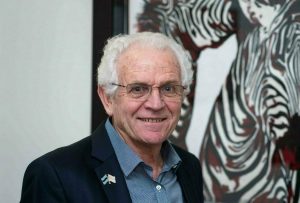The probable closure of Image and Report as paper newspapers brought home the reality of a world without paper newspapers. The response was unanimous: We still want paper newspapers. Especially also in Afrikaans.
But worldwide newspapers are dying by the hundreds. The influence of Google, Facebook and other digital platforms is overwhelming. They gobble up the advertising money that has kept newspapers afloat for centuries and draw the eyes of younger readers to the smartphone in particular. These have no problem with paper full of ink.
Therefore, it is especially older readers who experience the loss of newspapers. We grew up with them. They articulated our dreams. Also pain and disappointments transferred to us. We remember events based on newspaper covers.
Like the death of pres. Kennedy or Dr. Worn out. The first moon landing. The 1994 election. The attacks of 9/11. The Oscar Pistorius case. And Gerda Steyn’s smile.
Newspapers have been the primary news source for so many people for so long. This is why they became attached to a medium that miraculously survived for so long. Because no radio or TV broadcast has replaced the newspaper. It may have brought news to us faster or more vividly, but it did not replace newspapers.
Yet readers have been leaving newspapers in their thousands in recent years. They now read news on their smartphone. This is a common, worldwide phenomenon.
This happened not only because of the convenience of a smartphone, but the fact that newspapers have become thinner and no longer offer the same value for money. There were also other reasons for the shocking drop in circulation figures. Like hundreds of thousands of potential readers overseas. Or that the news has become so depressing…
We also soon forget that newspapers have always come and gone. Just think of the Transvaal, Capital, Morning paper and Fatherland. The end of Transvaal in 1993 was painful for some, because it had been a symbol of a political ideal for Afrikaners in the north of the country since 1937. But at least there were always alternatives.
So did Image emerged as the winner from the battle with the four Press Newspapers and articulated new ideals. In a time of transition, this beacon was important, even if the newspaper sometimes got it wrong.

In Johannesburg, which was dominated by English speakers, was The Transvaal a light beacon. The Afrikaners there wanted their own page to be a voice for them. So are the Eastern light in Port Elizabeth. In Natal, people like Theo Gerdener in the 1950s The Nataller help bring about. But it was a different era.
What do we lose when the last dailies would disappear as paper newspapers? A tangible proof of our being here. Newspapers that focus in our own language on those things that are important to us. It is part of our culture – tangible and also spiritual. It binds us together in a way. It has already been writing our history day by day for many decades.
The probable end of paper newspapers also means the end of a wonderful morning ritual. That of getting up when the newspaper falls on the front porch and you can flip through it with a cup of coffee and read it. (The citizen in the Cape is still safe for the moment, and I learned that the digital newspapers are available by five in the morning.)
We will miss the convenience of cutting out a report or photo. Or storing a photo in an album.
So I read in clippings from my grandfather’s funeral years before I was born. Or from my parents’ wedding. A slightly yellowed newspaper photo reminds me of a school choir in which I sang.
Later, as a journalist, I save reports or articles and look at them again forty years later. I can take my career out of a rut and revive it.
I was also able to compile an article from clippings that Prof. Willie Esterhuyse saved over his career. Yes, digital search engines are fantastic, when they work. But the paper clippings tell something more than the cold letters of a computer.

That is why it has also been my privilege in recent years to take down my newspaper collection and make it available to everyone in a digital media museum, Mediamense.com.
It preserves those historic front pages and imprints exceptional paper reports in our memory.
I also remember the lead processes that some of us experienced at the time. In 1979 I experienced something of that in Port Elizabeth. Also the rattle of Image ‘s roller press in Voorhout Street, Johannesburg, in the 1980s.
And don’t forget the people who were part of the production processes – the craftsmen who, over time, have largely been eliminated by technology.
Also, don’t forget the uncles and aunties who still organize teams to distribute the newspapers. Or the people who earn a little money by working on street corners on Sunday Report to sell. Or the boys who at the time were on Bloemfontein’s street corners Volksblad sold.
It is an entire organism that is in danger of being just a memory one day.
But this is not the end. Not at all. First, there are still community newspapers that appear on paper. That must be acknowledged.
Furthermore, I believe that journalism, Afrikaans journalism, will live on thanks to the Internet. The need for reliable, timely news has not gone away. In fact, news provided by professional journalists is much needed in an age of fake news.
That is why RNews, Netwerk24 and other digital news platforms are important. There are also so many possibilities on YouTube that are already being exploited. Furthermore, news on television and radio is lively.

Just as our grandfathers or great-grandfathers put their beloved horses in a retirement camp and bought a Ford, we who have come to love our newspapers will eventually accept and even enjoy the alternatives.
The onus is increasingly on news websites such as RNnews to take over the task of the newspapers of old. That RNnews is successful is gratifying. We as readers must do our part and help to build and maintain the page.
But the place of newspapers, paper newspapers with ink and character, we will not forget those.
- Prof. Johannes Froneman is curator of the digital media museum Mediamense.com as well as the Facebook page Mediamense Bylae.








